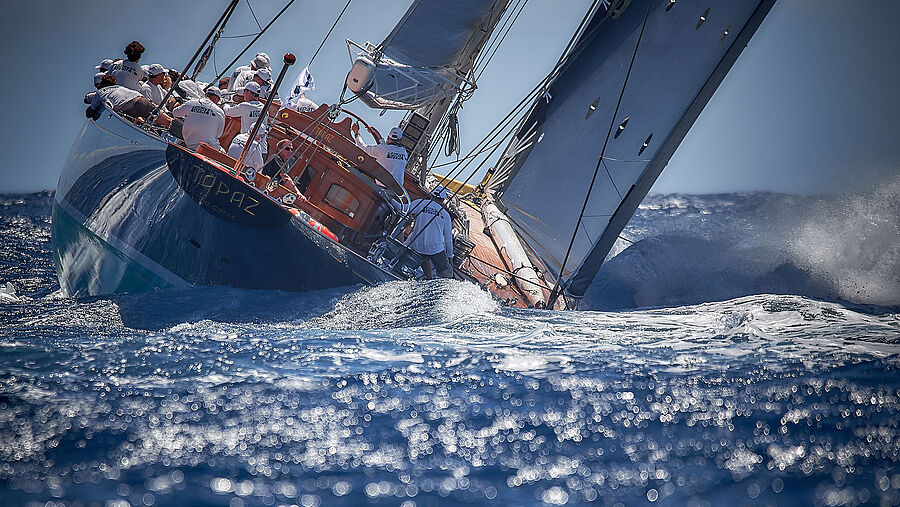When two ladies collide
On the 12th of March, during the hectic pre-start melee of the first race, the 43.6m J-Class yacht "Svea" collided with her classmate, the 42.6m "Topaz". Dramatic photo and video footage of the momentous crash showed Svea’s pointed bow apparently driving over Topaz’s deckhouse, sheet and rigging before slipping over the stern. The moment of misfortune attracted a lot of media attention and the footage spread across social media like wildfire.

When looking at the photographs, the fact that most of the people on board remained largely unharmed seemed almost miraculous. In the devastating accident, in which the question of guilt has not yet been conclusively clarified, two crewmembers from Topaz were injured and required immediate medical treatment. The two J-Class superyacht beauties, which were severely damaged in the collision, were able to return to port in Antigua under their own power, but had to surrender to their fate there. The complex story of the accident and its consequences for the two yachts should take quite a while from here on but the most important thing first:
Alongside care for the yacht, Pantaenius took responsibility for the return transport of the injured crewmembers. After receiving the necessary medical care on site, we organised the fastest possible return flight to a clinic in Germany, working in collaboration with the relevant insurer.
The Caribbean’s approaching hurricane season, as well as the worldwide Covid-19 lockdown measures, Pantaenius managed to mobilise its worldwide industry network, consisting of over 35,000 contacts and including more than 4,000 surveyors in all fields on all continents, within a very short period of time and engaged a surveyor who was located on the neighbouring island of Martinique. The surveyor was permitted entry to Antigua and, together with a surveyor appointed by the other party and a surveyor of this ship classification, the damaged J-Class yachts were subjected to comprehensive surveys and the subsequent repair options, which were still conceivable given the external circumstances, were considered.
The preferred plan, however, which was to have stabilising measures carried out on the rig as well as some immediate repairs made to the damaged area of the hull in Guadeloupe, in order to prepare Topaz for passage to New Zealand on her own keel, failed just a short time later. Covid-19 and the associated restrictions thwarted the initial transfer to Guadeloupe, with the port there having already been closed.
A longer-term plan was required and ever-faster action from all parties needed. Not only did the threat of a full coronavirus lockdown loom, which would limit and perhaps prevent all transportation options, but the slowly emerging travel restrictions increased the danger that the damaged Topaz would have to remain in the Caribbean indefinitely.
With investigations revealing that the ship could not be sufficiently repaired in the Caribbean so as to ensure safe passage, and taking into account that the crewmembers were European and that the ship was built in Europe, the ship's command, management company and Pantaenius decided to transport the ship to Europe by sea freight. Crucial to the quick decision at this delicate time, were the investigations and findings as to whether, and in what form, Topaz could be moved at all.
Pantaenius coordinated these decisive measures, and also dealt with the complex question of whether Topaz’s mast needed to be laid for transport. The testing of this high-tech rig required an extremely elaborate technique, which needed to be carried out before the transfer. The rig manufacturer managed to carry out the corresponding rig inspection at short notice and to assist all parties involved with qualified advice.
With the mast approved, Topaz was transported to Europe, as was Svea – Topaz’s opponent in the collision. Topaz is currently at a Dutch shipyard, where the repairs to the rig and hull are now almost complete. After closer examination it was found that apart from the punctual damage to the hull and rig, fortunately no other major parts were affected.
From one second to the next, Pantaenius was confronted with challenges; the magnitude of which had never been seen before. The incident and resulting required actions drew on our strength, experienceand our positive collaboration with third parties, which enabled close consultation and ensured that important decisions were made together between all those involved. Despite the pandemic lockdown, we were able to successfully maintain our service during this time. The positive result comes with special thanks to the personal and dedicated commitment of the captain, the crew and the management team, who all pulled together in these decisive hours.
The collision of the two superyachts is a tragic accident and we can not make any further comments on the cause its cause at this stage. Once again, however, it is clear that there is no passion without risk.
THE CARIBBEAN’S APPROACHING HURRICANE SEASON,
AS WELL AS THE WORLDWIDE COVID-19 LOCKDOWN
MEASURES, WHICH WERE ALREADY STARTING TO COME
INTO PLAY, MADE THE SITUATION A RACE AGAINST TIME
FOR ALL PARTIES INVOLVED.
FROM ONE SECOND TO THE NEXT, PANTAENIUS WAS
CONFRONTED WITH CHALLENGES; THE MAGNITUDE OF
WHICH HAD NEVER BEEN SEEN BEFORE.